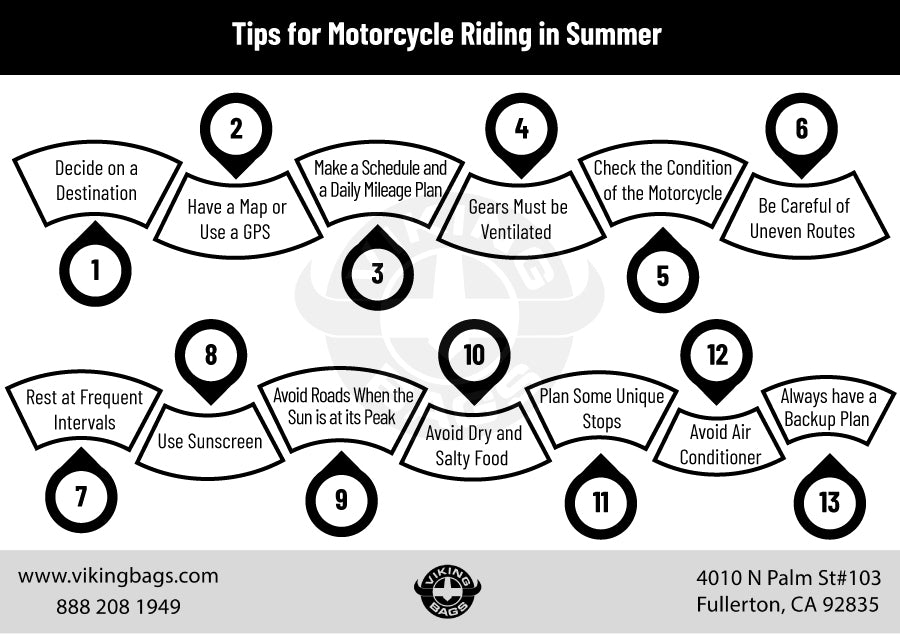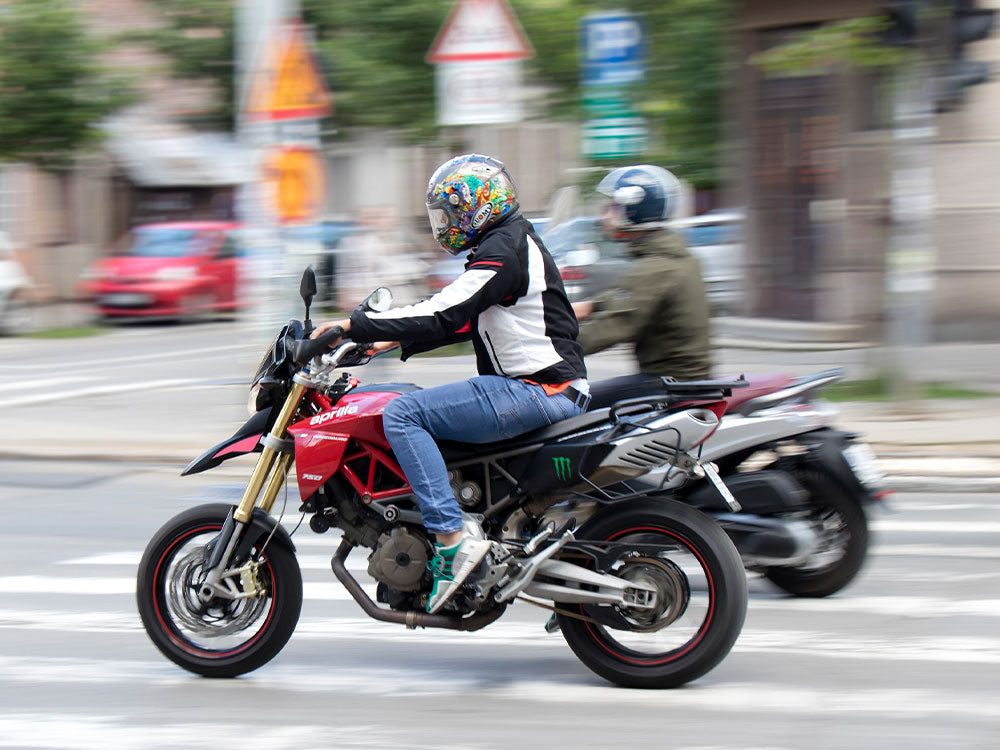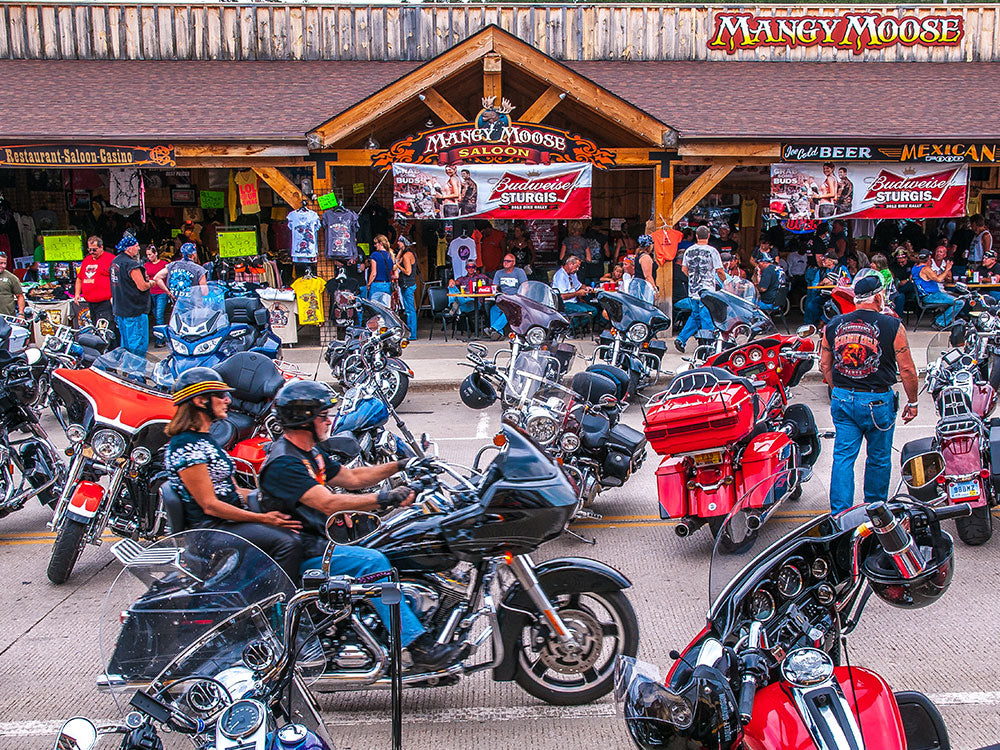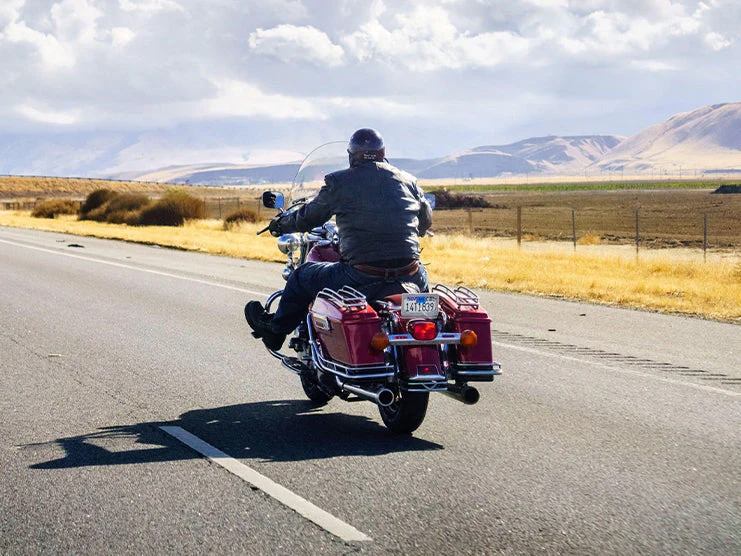Table of Content
Summer is the best season for motorcycle riding since there is less risk of precipitation. Motorcycle riders love to be on the road on a sunny day. However, roads are also highly exposed to the sun which can increase the risk of heat stroke. To enjoy a safe ride in the summer, riders must make careful preparations. Here are some tips for how to plan a summer motorcycle trip.

1. Plan Your Route
For motorcycle touring or cruising, it is important to decide on a destination before starting your trip. Motorcyclists must choose the final destination and which route to take to get there.
2. Use a GPS or a Map
For long motorcycle tours, riders should use a map or GPS for navigation. A GPS is considered the superior navigation tool nowadays since it gives directions in real time, shows alternate routes, and makes adjustments if necessary. When stopped, you can look at a map to look for any notable locations nearby or along your route.
3. Make a Schedule Based on the Distance
While riding across a long distance, plan how much distance you want to cover each day. Keep your schedule flexible in case of weather, closed roads, or other unexpected developments. Make sure to take into account regular stop breaks and sightseeing. Try to be realistic when planning how much distance to travel each day.
4. Keep Yourself Hydrated
Keep yourself hydrated when traveling in high temperatures. Water will help replenish any lost fluids due to sweating and keep you from becoming dehydrated. Dehydration can cause headaches, drowsiness, or death.
To keep yourself hydrated, drink lots of water and sports drinks or eat fruits with high water content. Avoid drinks with high caffeine content, sugary drinks, and alcohol.
5. Always Choose Ventilated Gear
Cooling vests and base layers help absorb sweat that evaporates and helps keep the body cool.
Mesh jackets maximize airflow throughout your upper torso at the cost of less protection. Leather jackets are tear-resistant and offer better protection.
Riding pants are made of lightweight and strong fabrics like leather that ensure longevity and endurance. Similar to mesh jackets, mesh riding pants have better breathability to ensure airflow but offer less protection.
6. Check the Motorcycle Carefully Before Going on a Ride
Before going on a ride, check the fluid levels. Also, make sure the radiator is clean and the tires have sufficient pressure with no punctures or leakage. In summer, air expands when the temperature rises. Tires continuously in contact with the hot roads could cause air pressure to increase in the tires. If over-inflated, tires can suddenly burst on the road.
7. Be Careful About Melted Bitumen on Roads
Bitumen layers in the road can become soft and melt during the summer due to the high temperature and being ridden by heavy traffic. This can cause the road to become uneven and slippery.
8. Take Breaks at Regular Intervals
Riding for long hours can result in heavy sweating, cramps, and fatigue which can make it harder to concentrate on the road. Riders must take breaks at regular intervals to rest, rehydrate, and cool down. Breaks also ensure a safe journey as riders have the opportunity to regain their energy.
9. Use Sunscreen
Ultraviolet rays from the sun can be harmful since they can cause skin diseases. To protect your skin from the harmful effects of these rays, make sure to apply sunscreen. Apply good-quality sunscreen on every exposed part of your body. Even if you do not have sensitive skin, sunscreen can reduce the risk of sunburn. Check the effective time of the sunscreen and reapply regularly.
10. Avoid Riding at Noon
If possible, try to avoid riding when the sun is at its peak at noon. At noon, the temperature is at its highest which can increase the risk of heat stroke. If you are on the road between 1 pm to 4 pm, try to stay in the shade and keep yourself hydrated.
11. Avoid Dry, Salty, and Sugary Foods
Try to eat a light breakfast as proteins and carbs need more water to digest. Avoid dry foods since these will fill your stomach and leave less room for water. Try to bring food with water content to ensure you stay hydrated and consume the necessary nutrients. Avoid any salty or sugary foods as these can cause dehydration.
12. Plan Stops at Notable Locations
Notable locations like historic sites or restaurants can serve as rest spots during a motorcycle tour. Try to find unique places to visit to make your motorcycle trip memorable.
13. Avoid Using the Air Conditioner During Breaks
Riders should avoid using an air conditioner for a long time while riding. An abrupt change in temperature can cause stress for your body. An air conditioner keeps your body cool, causing it to acclimate to the sudden lower temperature. When getting back onto the road with the air conditioner still on, your body uses up a lot of energy to maintain your body’s temperature relative to the environment. Instead, try to stay in the shade and keep the air conditioner off. If you use an air conditioner, try to keep it on only for a short duration.
14. Have a Backup Plan
Before going on a motorcycle ride, make sure to have a backup plan in case you run into any trouble, such as storms or faulty parts. Be prepared for any situation you might face on your trip.
15. FAQs
15.1 How to prepare your motorcycle for a long trip?
Answer: First, check the oil filter. Check all the fluid levels and air pressure in the tires. Monitor all the lights, signals, horns, or gauges. Inspect every side of your motorcycle to check for any broken parts. Lubricate the chain and adjust the brake cable. If you are going on a long trip, it is recommended you visit a motorcycle mechanic.
15.2 Which type of clothing should be avoided during a summer motorcycle ride?
Answer: Try to avoid wearing t-shirts, half-sleeve shirts, lightweight sneakers, shoes with laces, or dress shoes since they do not completely cover your body and provide little to no protection.
15.3 Which temperature is safe for motorcycle riding?
Answer: 35 ℃ or below is considered the ideal temperature range for motorcycle riding. 45 ℃ or above is considered too hot to go motorcycle riding.
16. Final Words
any motorcyclists go on long-distance rides during the summer. However, these types of trips require extensive planning and preparation. Firstly, riders must know what route to take to reach a destination. GPS or maps are reliable means of navigation that can help you get to the destination. In summer, it is important to prevent overheating and dehydration. Riders should start riding early in the morning or late in the evening to avoid the heat. Before starting a ride, it is also important to check the motorcycle properly. Stay hydrated by drinking plenty of water and eating fruits with high water content. Make sure to avoid eating salty or dry foods. Apply sunscreen to protect your skin from sunlight. After making all the necessary preparations, make sure to prepare a backup plan just in case. Follow these tips to ensure an enjoyable long-distance motorcycle trip. There are many aftermarket parts and luggage bags available at Viking Bags, including saddlebags, sissy bars, crash bars, handlebars, seats, backrests, and fairings.













Leave a comment
All comments are moderated before being published.
This site is protected by hCaptcha and the hCaptcha Privacy Policy and Terms of Service apply.